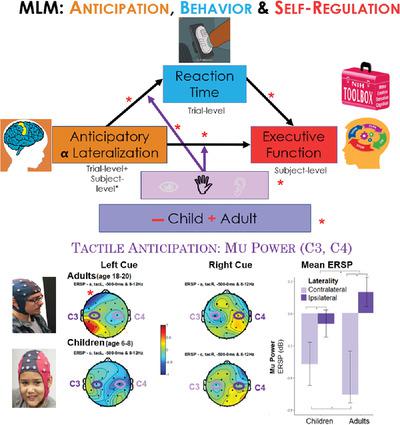Our official English website, www.x-mol.net, welcomes your
feedback! (Note: you will need to create a separate account there.)
Anticipation across modalities in children and adults: Relating anticipatory alpha rhythm lateralization, reaction time, and executive function
Developmental Science ( IF 3.1 ) Pub Date : 2022-05-26 , DOI: 10.1111/desc.13277 Staci Meredith Weiss 1, 2 , Peter J Marshall 1
Developmental Science ( IF 3.1 ) Pub Date : 2022-05-26 , DOI: 10.1111/desc.13277 Staci Meredith Weiss 1, 2 , Peter J Marshall 1
Affiliation

|
The development of the ability to anticipate—as manifested by preparatory actions and neural activation related to the expectation of an upcoming stimulus—may play a key role in the ontogeny of cognitive skills more broadly. This preregistered study examined anticipatory brain potentials and behavioral responses (reaction time; RT) to anticipated target stimuli in relation to individual differences in the ability to use goals to direct action (as indexed by measures of executive function; EF). A cross-sectional investigation was conducted in 40 adults (aged 18–25 years) and 40 children (aged 6–8 years) to examine the association of changes in the amplitude of modality-specific alpha-range rhythms in the electroencephalogram (EEG) during anticipation of lateralized visual, tactile, or auditory stimuli with inter- and intraindividual variation in RT and EF. Children and adults exhibited contralateral anticipatory reductions in the mu rhythm and the visual alpha rhythm for tactile and visual anticipation, respectively, indicating modality and spatially specific attention allocation. Variability in within-subject anticipatory alpha lateralization (the difference between contralateral and ipsilateral alpha power) was related to single-trial RT. This relation was more prominent in adults than in children, and was not apparent for auditory stimuli. Multilevel models indicated that interindividual differences in anticipatory mu rhythm lateralization contributed to the significant association with variability in EF, but this was not the case for visual or auditory alpha rhythms. Exploratory microstate analyses were undertaken to cluster global field power (GFP) into a distribution-free temporal analysis examining developmental differences across samples and in relation to RT and EF. Anticipation is suggested as a developmental bridge construct connecting neuroscience, behavior, and cognition, with anticipatory EEG oscillations being discussed as quantifiable and potentially malleable indicators of stimulus prediction.
中文翻译:

儿童和成人跨模态的预期:与预期 alpha 节律偏侧化、反应时间和执行功能相关
预期能力的发展——表现为与对即将到来的刺激的预期相关的准备动作和神经激活——可能在更广泛的认知技能的个体发育中发挥关键作用。这项预先注册的研究检查了预期目标刺激的预期大脑潜能和行为反应(反应时间;RT)与使用目标指导行动的能力的个体差异(由执行功能测量索引;EF)。对 40 名成人(18-25 岁)和 40 名儿童(6-8 岁)进行了一项横断面调查,以检查脑电图 (EEG) 中特定模态 alpha 范围节律振幅变化的关联在预期侧化视觉、触觉、或听觉刺激在 RT 和 EF 中具有个体间和个体内的差异。儿童和成人分别表现出触觉和视觉预期的 mu 节律和视觉 alpha 节律的对侧预期减少,表明模态和空间特定的注意力分配。受试者内预期 alpha 偏侧化(对侧和同侧 alpha 功率之间的差异)的变异性与单次试验 RT 相关。这种关系在成人中比在儿童中更为突出,并且对于听觉刺激并不明显。多级模型表明,预期 mu 节律偏侧化的个体差异导致了与 EF 变异性的显着关联,但这不是视觉或听觉 alpha 节律的情况。进行了探索性微观状态分析,将全局场功率 (GFP) 聚类为无分布时间分析,检查样本之间以及与 RT 和 EF 相关的发育差异。预期被认为是连接神经科学、行为和认知的发展桥梁结构,预期脑电图振荡被讨论为刺激预测的可量化和潜在可塑性指标。
更新日期:2022-05-26
中文翻译:

儿童和成人跨模态的预期:与预期 alpha 节律偏侧化、反应时间和执行功能相关
预期能力的发展——表现为与对即将到来的刺激的预期相关的准备动作和神经激活——可能在更广泛的认知技能的个体发育中发挥关键作用。这项预先注册的研究检查了预期目标刺激的预期大脑潜能和行为反应(反应时间;RT)与使用目标指导行动的能力的个体差异(由执行功能测量索引;EF)。对 40 名成人(18-25 岁)和 40 名儿童(6-8 岁)进行了一项横断面调查,以检查脑电图 (EEG) 中特定模态 alpha 范围节律振幅变化的关联在预期侧化视觉、触觉、或听觉刺激在 RT 和 EF 中具有个体间和个体内的差异。儿童和成人分别表现出触觉和视觉预期的 mu 节律和视觉 alpha 节律的对侧预期减少,表明模态和空间特定的注意力分配。受试者内预期 alpha 偏侧化(对侧和同侧 alpha 功率之间的差异)的变异性与单次试验 RT 相关。这种关系在成人中比在儿童中更为突出,并且对于听觉刺激并不明显。多级模型表明,预期 mu 节律偏侧化的个体差异导致了与 EF 变异性的显着关联,但这不是视觉或听觉 alpha 节律的情况。进行了探索性微观状态分析,将全局场功率 (GFP) 聚类为无分布时间分析,检查样本之间以及与 RT 和 EF 相关的发育差异。预期被认为是连接神经科学、行为和认知的发展桥梁结构,预期脑电图振荡被讨论为刺激预测的可量化和潜在可塑性指标。











































 京公网安备 11010802027423号
京公网安备 11010802027423号